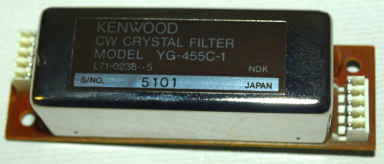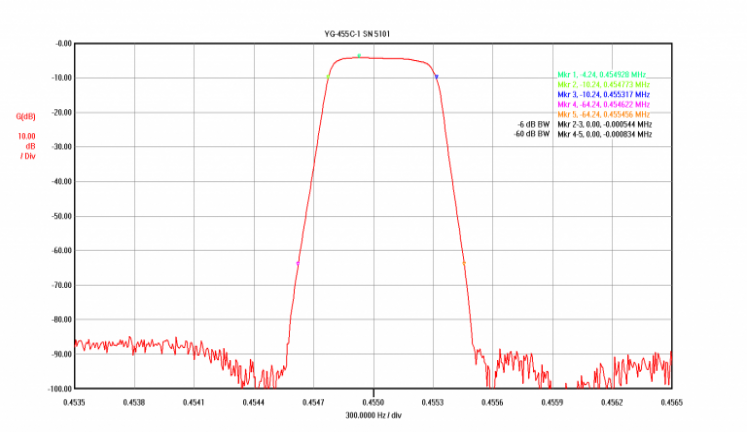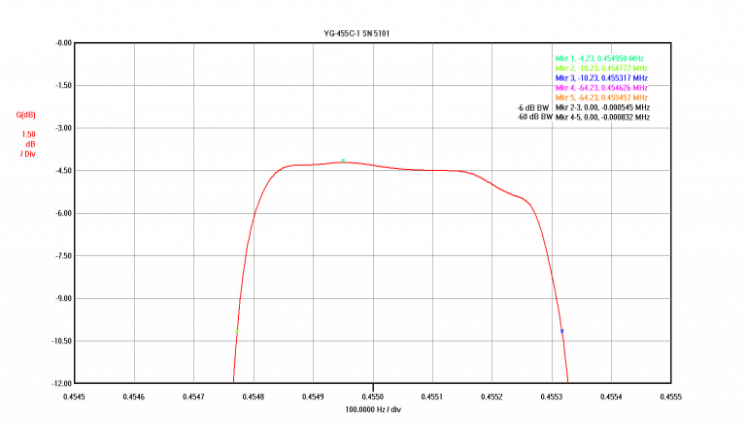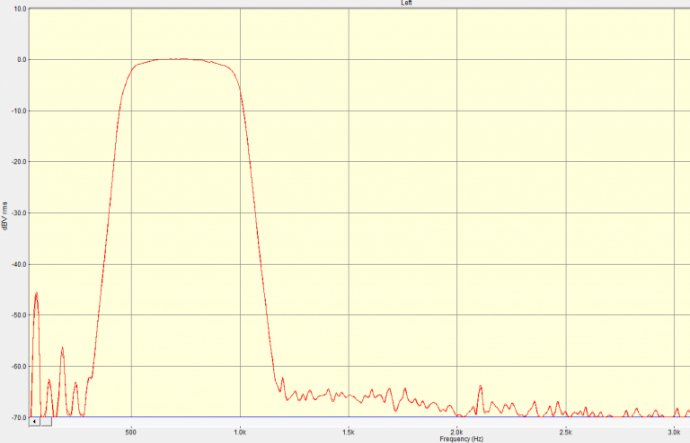455 KHz 500 Hz crystal filtering on a relative budget The YG-455C 2nd IF filter built for the TS-830s series is rare and as a result, expensive. However the YG-455C-1 is much more common as it was used in may newer Kenwood rigs. Being more plentiful it is (by comparison at least) more affordable. Here we put the repurposed YG-455C-1 to the test. Filter OptionsThanks to N6WK (SK) we can see the specifications of the various Hybrid family rigs in the table below.
Notice the center frequency (CF) of the two filters is off by 700 Hz. This CF difference is an important factor and probably is at the root of (incorrect) reports that the filter cannot be used. As we will see later the -1 filter is in fact is a drop in replacement for the YG-455C, with a couple of considerations that have very simple solutions. 
Meanwhile, back at Kenwood Hybrid HQ...I had not progressed beyond the concept of using the -1 filter in the '830s. And at about that same time a message popped up on the Kenwood Hybrid Yahoo group reflector which wiped away any remaining concerns. Chris W7JPG had published work proving this filter would in fact work - although in an indirect maner. Chris used the Collins mechanical 455 KHz filter in his setup (not the crystal one featured here) but because the Collins filter has the same CF as the crystal filter, the results would be similar. Test and check out of Chris's rig was done as part of a restore job by Terry K9TW. Click HERE to view the W7JPG/K9TW Collins Filter Install Notes There were two key conclusions from Chris and Terry's work applicable here. 1) A 455.0 KHz CF filter works as intended in the TS-830s, provided 2) the IF shift control is rotated to about the 9:00 position (which compensates for the CF difference). Why use the crystal vs. the Collins mechanical option? The Collins filter is a very suitable alternative to the YG-455C-1 crystal filter and has had wide adoption in ham gear for decades. It is a bit lower in cost (at that time) and I had considered the option, but decided to proceed with the crystal filter instead because the shape factor would be better thanks to a combination of less filter blow-by and steeper transition band skirts. Additionally, the installation would be simpler as it's a direct mechanical fit with the mounting holes and it would look just like the stock filter. YG-455C-1 Bench Characterization
I ordered a filter from an eBay vendor. Mine arrived a few days later and was in excellent condition. Notice the filter comes on a daughter board for snap-in solderless mounting as utilized in the later KW rigs. Prior to rig installation, some measurements of the filter's performance were made using an N2PK VNA. Matching the 50 ohm VNA I/O with the 2K filter I/O was simply made with series 2K resistors to approximate the filters.
No consideration was given to accommodating the
reactive load (usually 10-30 pf) - I assumed that at
455 KHz this would have a negligable effect on performance. And if there was a ripple problem with the filter mounted in the rig, I would check into it further at that time. BENCH TEST RESULTS - CF is about 50 Hz high.
- Insertion loss is 4.2 dB.
- -6 dBc bandwidth measured 544 Hz and -60 dBc BW measured 834 Hz for a shape factor of about 1.53:1.
- Ultimate attenuation is in excess of -80 dBc.

Looking closer at the passband the ripple present is minimal. The passband with the filter mounted in the rig will be a bit different as the termination load on both ends will likewise be different. 
Filter geeks would want to see the group delay. Pretty typical of this sort of filter. Group delay is actually what our ears percieve as ringing where the signal takes varying amounts of time to pass through the filter depending on the frequency. 
Nothing in the bench test stood out as exceptional. Filter was go for install! Performance in the TS-830sHaving determined that the filter was operational, I pulled the filter off the daughter board and mounted it in the rig. Adjusting the IF offset control to the 9:00 position and sweeping the spectrum resulted in this composite plot. AF for this test was sampled at the AF-OUT jack on the back of the rig, not across the speaker output. The noise floor is better than -60 dBc which was about the limit of the ad-hoc test setup used. The small bumps in the AF on the low end are 60 and 180 Hz pickup from the test bench and are not actually present in the AF feed. That is a very nice looking plot indeed! 
ConclusionsUsing the YG-455C-1 in the TS-830S works well and is a relatively simple install. Other than turning the IF shift knob, no other special provision needs to be made. The resulting composite passband of the two filters is impressive and the sweet CW sound I love about the rig was definately unaffected. There are a couple of caveats though. If you have the YG-88C installed, the VBT adjustment with these two filters in cascade is pretty touchy. It's possible to narrow down the combined filter further but I generally never do that in my application of rag chewing on the low bands so it's not been a hindrance. And you do have to remember to turn the IF shift knob when engaging the filter - putting this filter inline without turning the knob will result in that station dropping below the noise floor. This could probably be made an automatic operation with a couple of small relays/resistors (the control is dual-ganged so you likely have to offset both pots) tied to the CW-N switch but I did not look into it seriously. Thanks to Chris W7JPG and Terry K9TW for their published prior work. And to Gordon N6WK (SK), RIP. |